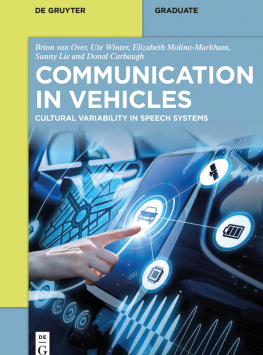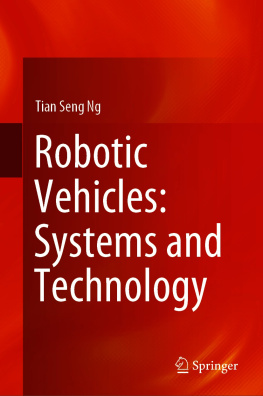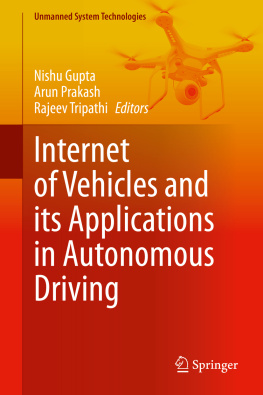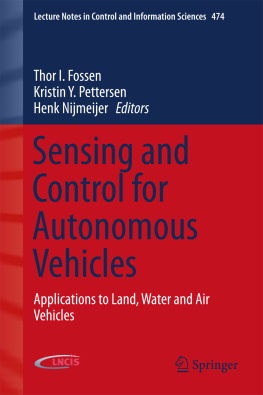
Brion van Over, Ute Winter, Elizabeth Molina-Markham, Sunny Lie, Donal Carbaugh
Communication in Vehicles
Also of interest

Intelligent Multimedia Data Analysis
Siddhartha Bhattacharyya, Indrajit Pan, Abhijit Das, Shibakali Gupta, 2019
ISBN 978-3-11-055031-3, e-ISBN (PDF) 978-3-11-055207-2,
e-ISBN (EPUB) 978-3-11-055033-7

Signal and Acoustic Modeling for Speech and Communication Disorders
Hemant A. Patil, Amy Neustein, Manisha Kulshreshtha, 2018
ISBN 978-1-61451-759-7, e-ISBN (PDF) 978-1-5015-0241-5,
e-ISBN (EPUB) 978-1-5015-0243-9

Understanding Security Issues
Scott Donaldson, Chris Williams, Stanley Siegel, 2018
ISBN 978-1-5015-1523-1, e-ISBN (PDF) 978-1-5015-0650-5,
e-ISBN (EPUB) 978-1-5015-0636-9

Lie Group Machine Learning
Fanzhang Li, Li Zhang, Zhao Zhang, 2018
ISBN 978-3-11-050068-4, e-ISBN (PDF) 978-3-11-049950-6,
e-ISBN (EPUB) 978-3-11-049807-3

Authors
Brion van Over
Manchester Community College
PO BOX 1046, Manchester CT 06045-1046, U.S.A.
Ute Winter
General Motors Advanced Technical Center Israel 7 HaMada Street, 4673341 Herzeliya, Israel
Elizabeth Molina-Markham
Northeastern University
University Scholars Program & Office of Undergraduate Research and Fellowships 411 Richards Hall, Boston MA 02115, U.S.A.
Sunny Lie
California State Polytechnic University
Building 1-319E, 3801 West Temple Ave, Pomona CA 91768, U.S.A.
Donal Carbaugh
University of Massachusetts Amherst N308
Integrative Learning Center
650 N. Pleasant St., Amherst MA 01003-1100, U.S.A.
ISBN 978-3-11-051891-7
e-ISBN (PDF) 978-3-11-051900-6
e-ISBN (EPUB) 978-3-11-051915-0
Library of Congress Control Number: 2019947838
Bibliographic information published by the Deutsche Nationalbibliothek
The Deutsche Nationalbibliothek lists this publication in the Deutsche
Nationalbibliografie; detailed bibliographic data are available on the Internet at http://dnb.dnb.de.
2020 Walter de Gruyter GmbH, Berlin/Boston
Cover image: Metamorworks/iStock/Getty Images
www.degruyter.com
Acknowledgements
This book has involved a team effort in the best sense of that phrase. As authors, we have worked together to conduct the research presented here. The formation of our research team is discussed in detail in the first chapter. While we have been central to the research reported here, we have also benefitted from all kinds of support. At General Motors, in Michigan, our works were aided immeasurably by Timothy J. Grost, Laura Rosenbaun and Yael Shmueli; in China, we worked carefully with Peggy Wang. We were also helped in some translations by Xinmei Ge of Acton, Massachusetts and Libin Hang of Donghua University, Shanghai.
This research was supported by grants from General Motors to Donal Carbaugh at the University of Massachusetts. The authors are grateful for this support. Carbaugh is also grateful to the Department of Communication, the College of Social and Behavioral Sciences and the university for its continued support of his research.
Earlier versions of some of the works presented here have been published: Carbaugh, D., Winter, U., Molina-Markham, E., Van Over, B., Lie, S. and Grost, T. 2016. A Model for Investigating Cultural Dimensions of Communication in the Car. In: Theoretical Issues in Ergonomics Science 17(3):304-323; Carbaugh, D., Winter, U., van Over, B., Molina-Markham, E. and S. Lie. 2013. Cultural analyses of in-car communication. Journal of Applied Communication Research 41(2):195-201; Carbaugh, D., Molina-Markham, E., van Over, B., and U. Winter. 2012. Using communication research for cultural variability in human factor design. In: (N. Stanton, eds) Advances in human aspects of road and rail transportation. CRC Press. Boca Raton, (FL), pp. 176185; Molina-Markham, E., van Over, B., Lie, S. and D. Carbaugh. 2015. OK, talk to you later: Practices of ending and switching tasks in interactions with an incar voice enabled interface. In: (T. Milburn, ed.) Communicating User Experience: Applying Local Strategies Research to Digital Media Design. Lexington Books. London. pp. 7-25; Molina-Markham, E., van Over, B., Lie, S. and D. Carbaugh. 2016. You can do it baby: Cultural norms of directive sequences with an in-car speech system. Communication Quarterly 64(3):324-347; Wang, P., Winter, U., Grost, T. 2015. Cross cultural comparison of users barge-in with the In-vehicle speech system. In: (A. Marcus, ed) Design, User Experience, and Usability: Interactive Experience Design. DUXU 2015. Lecture Notes in Computer Science, 9188. Springer; Winter, U., Tsimhoni, O., and T. Grost. 2011. Identifying cultural aspects in use of invehicle speech applications. Paper presented at the Afeka AVIOS Speech Processing conference, Tel Aviv, Israel; Winter, U., Shmueli, Y., and T. Grost. 2013. Interaction styles in use of automotive interfaces. In: Proceedings of the Afeka AVIOS 2013 Speech Processing Conference, Tel Aviv, Israel; Rosenbaun, L., Winter, U., and van Over, B. 2019. Voice Persona: Apologies in In-car Speech Technologies. In: (M. Scollo and T. Milburn, eds.) Engaging and Transforming Global Communication through Cultural Discourse Analysis. Fairleigh Dickinson University Press. Vancouver, B.C. pp. 35-53; van Over, B., Molina-Markham, E., Lie, S., & Carbaugh, D. 2016. Managing interaction with an in-car infotainment system. In: (N. Shaked and U. Winter, eds.) Design of multimodal mobile interfaces. De Gruyter. pp. 145-168.
1Cultural Analyses of In-car Communication
1.1Introduction
When we sit with our laptop, phone, or television, we are involved in an interaction with communication technology. We have our own ways of thinking, our culturally based conceptions about that technology, about what it is, how it might be of use, and also, of course, about how we will indeed use it. This general arena of activity is called by some, the humanmachine interface. This is of course a complex site of activity, and of study, as complexities of use lead to research reports with reports leading to the redesign of our technological devices or machines. This cycle of human use and research results in devices being the way that they are, and thereby sets the stage for end-users to use them in the complex and at times unexpected ways that we do.
One such device is being placed in the dashboard of cars or automotive vehicles generally. This sort of device allows drivers and passengers to adjust the temperature of the vehicle or the volume of speakers, to play a variety of radio stations, to play from personal music libraries, to make telephone calls, to navigate to destinations, and to conduct other such activities including the possibilities of messaging, conferencing, and other various forms of entertainment. Increasingly, multiple modes of interacting with such devices are being used. Earlier designs of these devices have relied mostly on push-button technologies. More often, now, a variety of modalities is integrated into a multimodal interface, such as touch screens or touch pads. When voice activation is used and when this is initially successful, for many tasks, users tend to like it.
Next page













